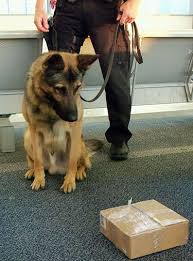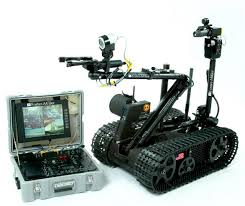Module 3 - Arson and Explosives
Lesson 3 - Explosives
Forensic Explosive Detection and Identification
![]()
The location of explosive devices can be determined in several ways. The most common methods of explosive detection used today include bomb detection dogs, bomb detection robots, X-ray machines, and metal detectors.
After a bomb has been located, be it detonated or not, investigators must identify specifically the type of chemical compounds that caused or could cause an explosion. This information may help to identify the suspect(s) and/or help prove which suspect committed the crime. The two most popular methods used to identify explosive compounds involve gas chromatography and mass spectrometry.
Bomb Detection Dogs: Because a dog’s sense of smell is thousands of times better than a human’s, most police departments use specially trained police service dogs to identify the location of explosives. These dogs are trained to detect the odour of hundreds of different explosive compounds. They cannot identify the type of explosive. When a bomb detection dog detects an explosive substance, it is safely and carefully detonated.
 Remote Mechanical Investigator: Remote Mechanical Investigator (RMI) units are robotic devices that are used to locate and safely remove explosive devices. An RMI is commonly used in situations where a bomb threat has been made or a suspicious package detected. In these instances, the area near the bomb is cleared to prevent human casualties. Several small cameras are mounted on an RMI to allow the operator to control its movements using a television monitor. The robot’s operator uses its extendable arm and oscillating hand to disarm, remove a bomb, and/or safely detonate a bomb. A RMI robot is expensive, and its use is often limited to large police departments.
Remote Mechanical Investigator: Remote Mechanical Investigator (RMI) units are robotic devices that are used to locate and safely remove explosive devices. An RMI is commonly used in situations where a bomb threat has been made or a suspicious package detected. In these instances, the area near the bomb is cleared to prevent human casualties. Several small cameras are mounted on an RMI to allow the operator to control its movements using a television monitor. The robot’s operator uses its extendable arm and oscillating hand to disarm, remove a bomb, and/or safely detonate a bomb. A RMI robot is expensive, and its use is often limited to large police departments.
X-ray Machines: Specially designed X-ray machines can detect and identify explosives determining the density of a suspicious object and comparing it to known densities of various explosives. These X-ray machines use special computer software to make positive readings. However, ultimately, the operator determines if the object contains an explosive. X-ray machines are used by some police departments, most airports, highly secure government facilities, and some schools.
Metal Detectors: Most explosives are contained within a metal casing. Therefore, a metal detector alerts its operators to the presence of metals—which might contain explosives. When this occurs, a suspicious object is then examined to determine if it is actually an explosive and not just a device that happens to contain metal. Similar to X-ray machines, metal detectors are also used by some police departments, most airports, and highly secure government facilities, and some schools.
EGIS: Erieye Ground Interface Segment, a military software package, is a highly accurate device that uses gas chromatography and mass spectrometry to detect the presence of plastic, commercial, or military explosives. To operate, a residue is collected by rubbing a special wipe on an object or a person. The sample is heated until it is becomes gaseous. Then, it is transferred into a separation chamber in which individual compounds are separated using gas chromatography. All the compounds containing nitro-groups are selected and identified using mass spectrometry. Many high explosives contain one or more nitro-groups [that is, nitrogen (N), nitrate (NO3), nitrite (NO2)], which is why the EGIS system focuses upon these. EGIS can positively identify a mass of these explosives as small as one trillionth of a gram. Hence, it is a highly effective detection method. The system’s primary disadvantage is that analysis requires quite a long time.
Ion Mobility Spectrometry (IMS): IMS technology can detect small quantities of explosives accurately and quickly. This technique uses jets of air to blow molecules from skin, clothes, or objects such as luggage. The molecules become electrically charged during this process and are drawn into a detector that identifies the explosives (or drugs) according to their distinct electrical properties. The error rate of the IMS is said to be less than 0.1%. Devices that use IMS technology come in various forms such as hand-held units, tabletop models, or walk-through systems that resemble the metal detectors used in airports.
 Honeybees have been trained to detect traces of explosives. A bee is trained to prefer different scents using sugar as a reward. After the one bee learns the cue, it passes this information to other bees, leading an entire hive to search for the new scent in a few hours. Honeybees are able to cover a large territory in a short time and are inexpensive. Some disadvantages to the use of bees include the inability to work at night, in storms, or in cold weather. They cannot be used in airports to sniff luggage. Currently, most of the detection work done by honeybees is the identification of landmines. Future uses of bees may include the detection of truck bombs.
Honeybees have been trained to detect traces of explosives. A bee is trained to prefer different scents using sugar as a reward. After the one bee learns the cue, it passes this information to other bees, leading an entire hive to search for the new scent in a few hours. Honeybees are able to cover a large territory in a short time and are inexpensive. Some disadvantages to the use of bees include the inability to work at night, in storms, or in cold weather. They cannot be used in airports to sniff luggage. Currently, most of the detection work done by honeybees is the identification of landmines. Future uses of bees may include the detection of truck bombs.